Only one product is directly downloadable- our Marlasoft Portal software manager which will automatically (with your approval) fetch the needed software to run ALL our solutions. It is also responsible for registration and new purchases if needed. You can click on an item below for more information, but when your solution needs one of these components, your installed Marlasoft Portal will fetch it for you.
At Marlasoft, we are the software developers for MindGate, and we are all about solutions!
That is why since 1986, we have provided the best business printing solutions, and since 2010 some of the best website and app
solutions on the web. Many times we feel that our customers do not like us, because
we never hear from them. When we ask why? they say…
because your software just works!
Marlasoft was recently formed into a small privately held Corporation of Florida. It has the same engineers that developed the MindGate.com products, ever since it was formed in 1986. Our engineers have PhDs and master's degrees in Math and Physics and Software Development, and are now we are official tech support and sole distributors of all MindGate.com products.
Marlasoft's most recent development is the release of OpenPrint, a completely rewritten and modernized version of PrintChef, which is capable of working with all of your existing PrintChef print recipes. It has a simpler user interface, easier registration, and more functionality than PrintChef.
Marlasoft's first success for MindGate was to develop Riyadh Airport operations software in Saudi Arabia; and subsequently, we developed the U.S. Strategic Defense Initiative (SDI or Star Wars) EV88 defense software- where we made a real "War Games"- not fake like the movie. Some of our products are still used today! In 1990, defense cutbacks refocused our attention to commercial software, and we turned to the Mac, and then in 1995 to Windows.
From the introduction of our first Mac product LaserMerge in June 1992, to the latest version of PrintChef in 2016, and now OpenPrint in 2021, we have been dedicated to the production of top quality, friendly, and extremely powerful solutions for banking, hotel management, check printing, utility billing, grade reports, mass mailing (U.S. PAVE certified) with CASS certification, and a host of other products that solve every kind of printing problem a customer might have. In fact, since its introduction in late 1998, our base product PrintChef has only had 7 customers whose problems were so complex that we could not solve them.
While we have good ideas, not everything we do becomes a marketable product. Through the late 90's and early 2000, we worked with HP and Stamps.com to deliver print-to-mail systems, print-your-own stamps, binding machines and printing solutions only suited to our print engine. Today, Stamps.com uses a different delivery mechanism, and HP never did complete its "BindJet" laser binding system for customer delivery. We were disappointed needless to say! Going our separate way, in 2012, we introduced MailHouse, our mass-mailing adjunct to PrintChef and now to OpenPrint... introducing the concept of printing-to-mass-mail!
Lately, we have turned our attention to the next generation of PrintChef called OpenPrint. Additionally, we have developed for the worldwide web real estate web sites, virtual touring systems, iPhone and Android apps, and web cards. To get a better understanding of the road we have taken and the plans for our future products, please feel free to examine our "Solutions" and "Timeline" pages.
We are now located in Florida having recently moved from the quiet hills of Tennessee where we also worked for high-technology agencies like those in Huntsville's SDC (strategic defense command) and NASA's space and rocket center, and for Tullahoma's Arnold Air Force base. High tension work for sure, but since we were also located 20 miles from Jack Daniel's Distillery in Lynchburg, we knew how to play as hard as we worked! After 35 years, we have recently moved our software development company Marlasoft to Florida, where we will continue to support all of our MindGate products and develop new sofware to make your printing easier.
As MindGate, we started in a garage like most Macintosh and Windows companies. Our software stability and lack of bugs is largely due to Martha Scarbury, with a masters in mathematics; and who is now Marlasoft's President; and an individual with an uncanny ability to break any piece of software. She is responsible for the proven stability of our products and their endurance over two decades.
Our founder, Lawrence Beyl, with a Ph.D. in Physics and sofware development, has stepped out of MindGate's presidency to run Marlasoft development; and we expect this team to generate new and efficient solutions. Our software was the principle reason for our success in the defense industry.
Our focus as a company is to provide solutions that "just work".
And, while we have the
best support team in the industry, generally our solutions just don't need it. In fact,
most of the time our customers contact us to register, get a solution for their printing,
or to finally purchase. Our "bug report" ledger is very thin!
But, even with these formidable talents, occasionally a bug will get by us or we may miss a market opportunity! And, this is where Marlasoft stands apart from other companies- we actually listen to our users! And, unlike other software companies, Marlasoft distributes most of its upgrades free-of-charge... that's because we don't expect you to pay for our mistakes or oversights!
Please feel free to investigate our solutions, contact us for questions, or try some or our web-based stuff. For 35 years, we have kept the same people, providing solutions to Mac and Windows since their inceptions. And, we expect to keep up this tradition at our new location in Florida mostly because the web has made us mobile. We CAN help you with your printing solution... that is what we do!
At MindGate, we said printing was a science- that is why our products work with every application and every printer. Our motto for Marlasoft is that printing is an art and beautiful, but the reality is that what we do is both an art and science. Check us out!
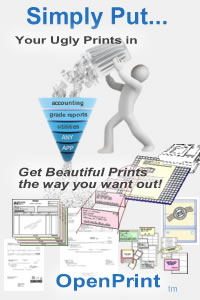
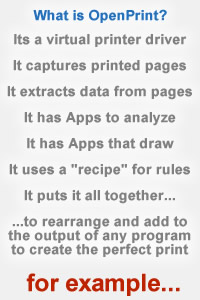
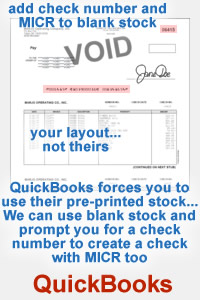
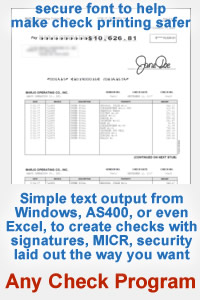
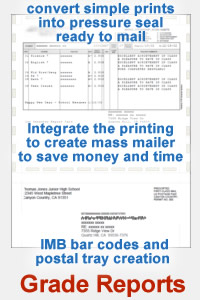

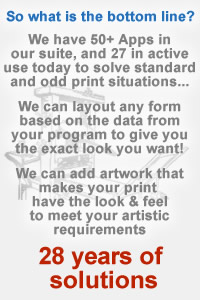
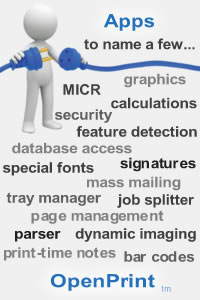

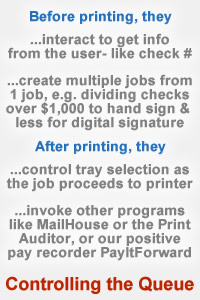
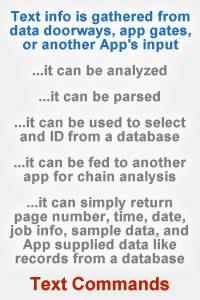
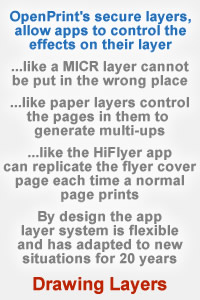
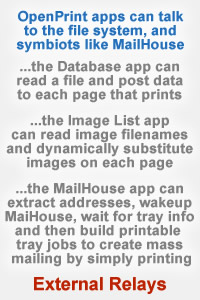
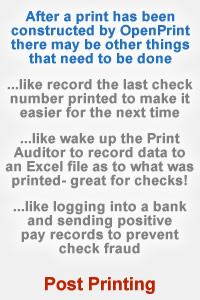

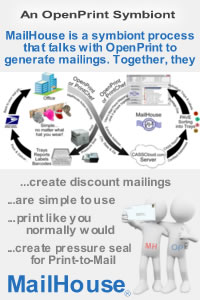
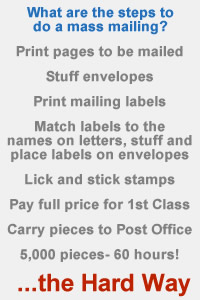
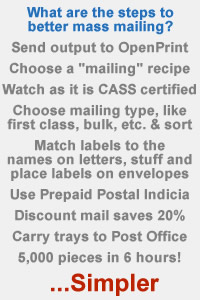
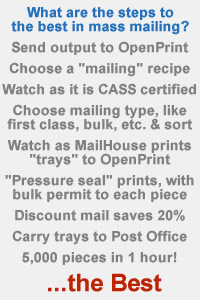
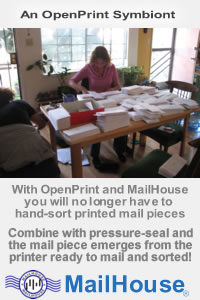
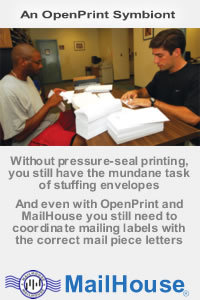


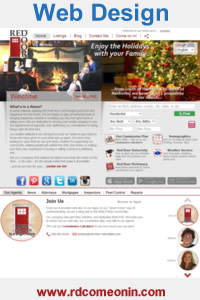

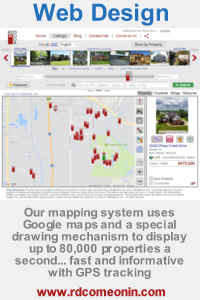
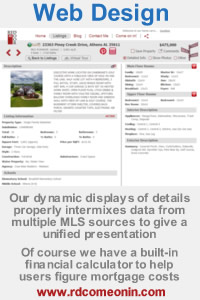
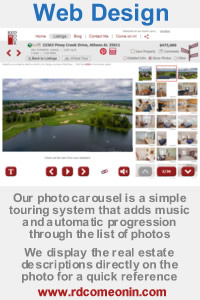

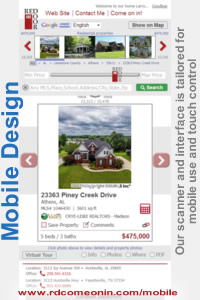
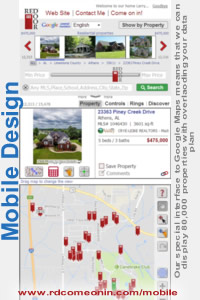
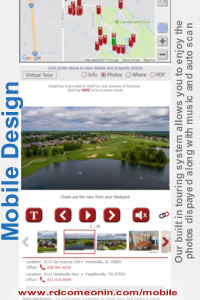
PAVE Sortation to Printing
It is anticipated that OpenPrint will be released this month after nearly 8 years of development, improvements over PrintChef, and the updating of nearly 70 plugins that were turned into APPS to make them compatible with OpenPrint. All customer solutions are guaranteed to still work correctly on this new system if they choose to upgrade to OpenPrint.
Marlasoft was formally formed into a Florida corporation, and will soon replace MindGate.com for the marketing and development of software.
The introduction of the Marlasoft portal adds a whole new level of simplicity to our software. The portal becomes the only software the user has to install from the web. Once installed, other software can be fetched via the portal, register with the portal, paid for with the portal, and managed with the portal. It even has the ability to automatically fetch plug-ins (APPS) needed for print recipes.
After nearly 2 years of development, the Marlasoft ReStream Server has completed the creation of a server DLL that could properly produce, read, and print PDF files. This server has not been marketed as an independent product, but will be incorporated into Marlasoft's OpenPrint to allow designers to include PDF layers, drag and drop PDF files as if they were print jobs, and to also produce flattened PDF files directly from OpenPrint.
Marlasoft completed 18 months of development on a web card designer tool. The web page webcards4me.com introduced the ability to design and produce electronic greeting cards online. It was never marketed, but the knowledge gained would be used in creating the new OpenPrint recipe designer.
This was Marlasoft's first non-PrintChef commercial development. Initially, this website encompassed full MLS listings for North AL and Southern TN, including the ability to map 80,000 properties in less than 2 seconds. For convenience, this website was reduced to a simple page referencing standard MLS websites.
This website introduced the ability to track through a house frame after frame with hot spots and click thru to each part of a property as a static photo virtual tour, versus a 3D virtual tour. Simple Tour was implemented in the Red Door Real Estate site to tour any property posted in an MLS.');
The release of the MailHouse plug-in was a key step into creating the symbiotic bridge between MailHouse and PrintChef/OpenPrint. This plug-in has 4 purposes: (1) to extract addresses from the user's printed page, (2) validate characters in the extracted address, (3) lock the print job so it cannot be easily deleted or modified, and (4) to receive lists of pages identifying how to create the mass mailing postal trays.
The new component library supports multiple themes, adds button design and color control to all of Marlasoft's products
This plug-in was originally designed to provide a tool for creating Intelligent Mail Bar Codes. However, after the introduction of MailHouse, the feature was absorbed into that product, and the bar code is no longer directly distributed.
This plug-in was designed to convert text input into the Optical Character Reader font and generate a proper OCR-A bar code with proper checksums in the created image. This plug-in is used to produce documents that are compatible with linear OCR high-speed scanners.
This plug-in was originally designed to provide a tool for creating Intelligent Mail Tray Labels. However, after the introduction of MailHouse, the feature was absorbed into that product, and the bar code is no longer directly distributed.
While PrintChef has been stable for 20 years as of this writing, its architecture needed a few improvements and its user interface a modern upgrade, including the release of a print-recipe designer. OpenPrint is Marlasoft's answer to these upgrade requirements. Development began and has stopped multiple times, as the PrintChef solution kept working (with minor updates) and so it was not clear if the effort was worth while. However, Marlasoft is intent on bringing the best of printing solutions to you, so development continues.
The Marlasoft engineering group was founded at the conception of MindGate but has worked in the background of all projects as the key development team.
This plug-in release was designed to allow a tab-delimited database to be used as both a source of bank information and automatic check number control. The plug-in would use an ID key to read a record, get the latest bank information for that key; and the next check number. It would then update the database check number for the next run.
This plug-in satisifed the generation of 5,9, and 11-digit Postal Bar Codes, and produced proper checksum digits based on the number sequence. This plug-in was discontinued with the introduction by the U.S. Postal System of the Intelligent Mail Barcode.
This plug-in release gave the capability to read database files like Excel spreadsheets. The input data could then be used to control recipe layouts and add to data in the layout. One example of this was using the reader to control bank information on check printing for multiple companies.
This plug-in was used to collect multiple text data (from the user's printed page) and then add (or operate on the data) for a result. For example, this was used to handle subtotals on a multi-page prints where the program printing did not generate one. The layout and summary design were part of the print recipe and used for the calculator's results.
This plug-in was designed to convert text input into the Code 39 bar code and produce proper checksums in creating the image. This differed from other bar code programs which relied on fonts to produce the bar code. The PrintChef/OpenPrint layer system provided access to all the drawing tools to create the barcode as an image
This plug-in was designed to convert text input into the European Article Number (EAN) bar code and produce proper checksums in creating the bar code image. The digital representation is under user design control.
This plug-in was designed to convert text input into the Uniform Product bar Code (UPC-A) and produce proper checksums in creating the image. The digital representation is under user design control.
This plug-in release brought skills to the context of numbers. It could reformat numbers to insert decimals and commas, or convert numbers to words as is the case in the written dollar amount on a check.
This program extended the Alabama A&M system to include the Learning Cycle and the management of planning in the university. The product was dropped a few years later and discontinued at MindGate.
The release of this program and its plug-in were combined to extract critical data from a print run for the purpose of cataloging that data. Many customers used it to log prints, what was printed, which customer, and in some cases extracted amounts for cross-check accounting. The plug-in extracted the data to a transaction file where it was subsequently processed by the Print Auditor program.
It became clear that MindGate was not ready for the dot-com revolution, so in 2005 we started to remake the corporation into the MindGate.com Corporation and its engineering group Marlasoft, which actually was part of a standalone unit. MindGate.com became a marketing company, while the Marlasoft group became the tech support, and continued to support all PrintChef products and plug-ins. Later the engineering group would formally form Marlasoft to lock down the licensing and patents on the software, while giving exclusive distribution to MindGate.com
This plug-in release brought cover management to the production of flyers by allowing the user to define the cover page as a background image on every page that printed. This was great for school and church flyers to place a changeable watermark behind the printed page.
This package release was for pre-printed check stock. It only provided data layers to remap either Accounts Payable or Payroll data onto existing stock. It also included the MindGate Mailer plugin.
This was a simplified version of the Check-to-Mail plug-in and simply moved, scaled, and clipped the printed results of the current output to rearrange that output on pre-printed stock. No additional graphics or other processing was performed. Great for turning a normal print into a pressure-seal document.
This plug-in release was designed to search a printed page's output to create sections of information, and then rearrange those sections into pre-sized tables to improve the look of the printed output.
This plug-in release was designed for the CIMS payroll and tax system. NOTE: It is no longer in use.
This plug-in release gave the ability to deconstruct text that was supposed to be an address block and then returned the components for use in address lookups and mailings.
This program helped Alabama A&M meet critical Government requirements for planning and processing lessons and future operations.
This plug-in was designed to convert text input into the Code 25 bar code and produce proper checksums in creating the image. This differed from other bar code programs which relied on fonts to produce the bar code. The PrintChef layer system provided access to all the drawing tools to create the barcode as an image.
This plug-in was designed to convert text input into the Code 128 bar code and produce proper checksums in creating the image. This differed from other bar code programs which relied on fonts to produce the bar code. The PrintChef layer system provided access to all the drawing tools to create the barcode as an image.
The PCX:Commands plug-in was released to supply the text stream and printed output with information like user, file name, page number, time of day, etc. These commands could then be integrated into other text flow to create printed results.
This package release contained recipe designs to remap W2, W4, 1099 tax data into proper format for filings in the current year. The tech support plan buys automatic updates each year to the latest form.
This package release contained recipe designs that remapped output from payroll and direct deposit prints into the format desired.
This plug-in release became the building block to most output graphics in the print. With capabilities for lines, circle, rectangles, etc., filled or unfilled, warped or normal, with or without borders, it satisfied most requirements for building tables in the printed output.
This package release contained recipe designs that remapped output from accounts payable prints into the format desired.
This Check-to-Mail package release put together a complete check printing solution for business and included the capability to insert logos, MICR, signatures, security, and manipulate the mailer area. It also came with the MindGate Mailer, Graphics, Security, MICR Line and Electronic Signature plugins.
This plug-in shows the dynamic power of the PrintChef plug-in system. Hewlett Packard was looking for a way of printing a toner stripe on the outer edge of every page of the document. Some stripes were to be striped with front-side angled one way and back side angled opposite. Some stripes were solid.
The purpose of these stripes was for the prototype BindJet system, which would collect front-back prints in a tray, and then move them to a binding device that would press and heat them on the edge with the PrintChef binding marks. The heat would then melt the pages together, since the toner was essentially plastic. The striped patterns were used to create NCR forms where multiple trays could supply colored paper and the striped pattern made them easy to tear apart. The solid marks were designed to create permanently sealed binders, like perfect bound books.
This project was discontinued in the U.S. when the dot-com bubble popped.
PrintChef Pro 3 for both Macintosh and Windows was released. It incorporated printer security, impositions, booklets, watermarks banners, bar codes, and signatures. And, most importantly it brought Variable Data Imaging (VDI) to RIPS for high-speed printing.
PrintChef Pro was used to produce the Production Imprimee et Multimedia, number 34, Jan-Feb 1998. In this production, PrinChef read the subscriber's name from a database, and then instead of adding a sticker to the outside and mailing, the name and even some personalization was added to the print of each magazine.
Not only was the cover modified to personally address the customer by first name, but the information was also used on subsequent pages in the magazine to give the reader a feeling that it was written just for them.
After viewing PrintChef's capabilities in generating RIP in-system imaging to speed up the processing, MindGate became part of the Colorbus exhibit at CeBIT 1997.
Following the CeBIT conference and amist turmoil in leadership of Colorbus, MindGate signed a contract to develop PrintStorm, a Colorbus specific version of PrintChef and its Variable Data/Image (VDI) capabilities when printing to the RIP.
This advertisement represented our transistion from LaserMerge Electronic Paper to PrintChef and the adaptation of PrintChef as a Variable Data/Image engine for the Colorbus RIP.
This was one of many ads to announce the transition from LaserMerge to PrintChef.
MindGate helps push MacWeek advertising.
Colorbus Inc. this month released a new series Cyclone color RIP server for copiers and large format printers. In other news, Colorbus said it will bundle PrintChef Pro variable-printing software with its Cyclone models. Developed by MindGate, the application can individualize documents for direct mailings.
Developed PrintChef,PrintChef Pro, PrintTracker, PrintMailer, Fill-in-the-Blank, and Tiling Helper. based on experiences gained from LaserMerge.
MindGate delivered PrintStorm and user manual to Colorbus for use in speeding up their RIP system and making prints 2-3 times faster. Colorbus was bought up shortly after that and the program was dropped as part of their system.
It was clear that LaserMerge opened a door, but PrintChef became the end-user product to market. New manuals were written and the program was set on the course for both Mac and Windows, with the first release in 96 to Windows 95 systems. Since that time PrintChef has been compatible with all versions of Windows from 95-ME, NT-XP-7,8, and 10.
This was part of an advertising campaign for LaserMerge Electronic Paper.
Almost from the beginning, Hewlett Packard was looking to MindGate to produce a means for creating pressure-seal from normal prints. The idea was to print a normal invoice, and then move the contents and extract addresses to create a pressure-seal mailer without the customer having to change anything but adding a machine. MindGate still has the 4th machine of the HP 4000 printed equipped with MICR encoding for check printing and pressure seal.
Developed a Ground-Entry-Point simulation for SENTAR in Huntsville using object-oriented design. It was implemented using Ada tasking and dynamic process creation.
The first release of LaserMerge Electronic Paper began shipping with cassette disk distribution, shrink wrap and mailing of physical boxes. LaserMerge was strictly a Mac product and was compatible with all versions.
Began development of LaserMerge Electronic Paper for the Macintosh. The design was based on the remapping logic developed at TRW to pre-load logos and other markings to the Postscript driver and repetitively burn them without reloading. This process sped up printing 2-fold. Later, the industry dubbed this technique Variable Data/Image printing.
Subcontracted to TRW on the Experimental Version Performance Assessment (EVPA, 1990). Developed the Run-Time Executive (RTE), which was responsible for the application layer interface to the real-time distributed testbed environment of the U.S. Army Strategic Defense Command's Experimental Version battle management prototype programs.
Subcontracted to TRW on the Experimental Version 1988 (EV88, 1988). Developed the Integration Test Environment (ITE), which made it possible to interrogate, modify, and collect or substitute data into the real-time distributed system during the run with minimal interference. This included the development of the ITE language and command controls. Developed the Experiment Generation System (EGS), which was used to launch distributed flight test experiments.
This program was critical to the validation of experiment integrity and reduced coordinated multi-machine experiment runs from two days to two hours. Developed the real-time tracking algorithms to support both cluster & object-based tracking. Developed infrared discrimination prototypes, & supplied the interfaces to ensure the system integrity. Developed the automated DoD-STD-2167A document generator. Assisted in the development of the Ada code formatter.
Tasked by Bechtel to implement a PolyForth installation and train Saudi programming students to run the Riyadh Airport. This project involved distributed processing of 200 micro/minicomputers (PDP-11) and 20,000 sensors.
Taught System Programmers in the FORTH language for eventual operation of the King Khaled International Airport's Digital Data System (DDS). Scope included real-time processing in a computer system, operating system architecture, language & compiler design, and the construction of a CPU-independent assembler. DDS was a large real-time control system which included over 200 micro/minicomputers with redundant components and over 20,000 sensors designed to monitor and control fire, life, and safety, HVAC, airfield lighting, water treatment, fuel farm, and security.
Subcontracted to TRW on the Advanced Processor for Infrared Sensors (APIRS, 1987). Developed the infrared focal plane simulation code SENSIM, which was designed to simulate different sensor systems at both the sample and object level. Developed the Variable Constraint Integrated (VCI) Pulse Matcher and Classifier, which was capable of on-focal-plane data processing through systolic operations. Developed alternative tracking methodologies for use in the pattern matching of clusters in scan-to-scan correlation and color correlation algorithms. Subcontracted to TRW and pioneered the design of the MindGate neural network testbed.